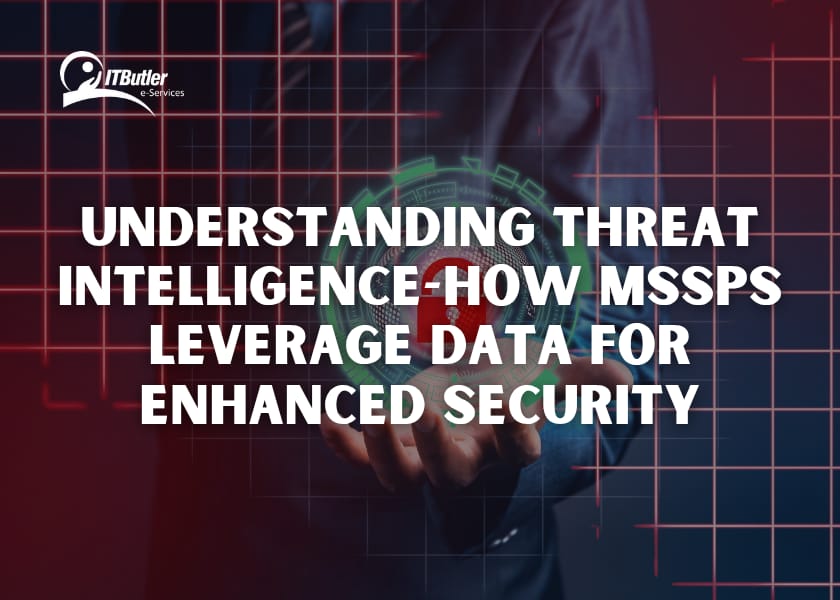Imagine you’ve got firewalls, antivirus software, and a security team monitoring your systems 24/7. Yet somehow, hackers always find a way in. But why? Because they use advanced techniques, constantly evolving their attacks. So the question is, are you keeping up? Threat intelligence in MSSP is utilized to handle substantial security data collections that enable them to identify potential threats early and provide swift responses. But how do they do it? Let’s discuss it next because security experts have prepared a straightforward explanation of the matter.
What is Threat Intelligence?
We must define threat intelligence before discussing Managed Security Service Providers (MSSPs).
Security teams obtain real-time threat data from cyber threats to both predict attacks before they happen and perform early detection and successful prevention. However, a security camera system for digital domains works like a predictive force that prevents unauthorized breaches from occurring.
How Does It Work?
The collection process of threat intelligence obtains massive amounts of data from three primary sources.
- Hackers use dark web forums to establish attack plans.
- Malware analysis reports
- Phishing campaigns
- Security logs from global networks
- Lastly, AI-powered behavioral analytics
Thus, organizations use pattern detection against cyberattacks with the analyzed data to establish threat-blocking strategies.
Types of Threat Intelligence
- Strategic Threat Intelligence presents generalized pain points about cyber threats such as the expanding number of ransomware attacks.
- Tactical threat intelligence informs organizations about specific hacker methods such as “Hackers exploit new Microsoft vulnerabilities.”
- Operational Threat Intelligence category provides information on actively spreading threats showing specifics on “This particular malware spreads at this present time.”
- Technical Threat Intelligence provides threat-specific information through indicators of compromise indicators such as harmful IP locations, file hashcodes, and harmful URLs.
Therefore, businesses that lack threat intelligence information react to cyberattacks once they have occurred. So MSSPs create progress through their ability to predict threats.
Role of Threat Intelligence in MSSP
Businesses use Managed Security Service Providers (MSSPs) as third-party security organizations which shield them against cyber attacks. So MSSPs continuously monitor networks to stop potential threats during all hours of the day throughout the whole year.
Moreover, MSSPs deploy threat intelligence through what methods to maintain network security?
1. Continuous Monitoring & Threat Detection
Their AI-based analytic tools review enormous security data collections that include network logging alongside user behavioral activity.
Hence, the observation of failed login attempts made in multiple countries will trigger their threat detection protocol.
2. Automating Threat Analysis
AI technology together with machine learning allows MSSPs to assess security alerts in real time. Instead of security analysts manually sorting through thousands of alerts, automation filters out the noise and focuses on real threats.
Moreover, MSSPs possess the ability to stop ransomware attacks automatically if they detect known malware signatures.
3. Proactive Threat Hunting
MSSPs apply threat intelligence to conduct active threat investigation which occurs before potential attacks become threats.
So the MSSP uses threat intelligence information about a particular domain to implement a system-wide block on all client network phishing emails.
4. Incident Response & Threat Mitigation
MSSPs respond with lightning speed to cyberattacks instead of just alerting their clients about them.
Therefore, the detection of ransomware requires system isolation and blocked malicious traffic with immediate notifications to security teams.
5. Compliance & Risk Management
However, maintaining continuous threat monitoring and incident reporting MSSPs allows businesses to fulfill their security regulatory requirements including GDPR, HIPAA, and PCI-DSS.
Therefore, organizations benefit from threat intelligence services that enable MSSPs to cut down losses while keeping a step ahead of cyber threats.
How MSSPs Use Threat Intelligence Data
MSSPs purposefully utilize security data collected in specific ways. So here’s how:
1. Dark Web Monitoring
MSSPs regularly screen hacker discussion boards and dark web commercial spaces to search for stolen authentication details and corporate information breaches as well as upcoming cyberattack plans.
Moreover, the MSSP takes prompt action against passwords that materialize on dark web marketplaces to reset their passwords immediately.
2. Threat Intelligence Feeds & AI Analysis
MSSPs obtain security data through threat intelligence streams that actively track new malware discoveries and phishing attacks with zero-day vulnerability details.
Moreover, MSSP detects newly discovered Windows server vulnerabilities before hackers can use them through immediate server updates.
3. Behavioral Analytics for Insider Threats
MSSPs implement AI systems to track workforce behavior which enables them to identify unusual conduct throughout company networks.
Moreover, employee downloads of extensive data during early hours will lead to insider threat alerts through MSSP systems.
4. Predictive Threat Intelligence
AI-enabled analytics at MSSPs function to anticipate future cyber threats rather than act after an attack happens.
So when AI systems detect rising ransomware activity on worldwide networks MSSPs send warnings to their clients before attack initiation.
5. Automated Threat Blocking
MSSPs use threat intelligence data to protect their clients along with endpoint defense systems and email filtering tools
Furthermore, MSSPs enact instant security rule modifications that block new phishing email campaigns through their systems. They apply security data to build a proactive AI-based system that protects against cyber threats.

MSSP Threat Intelligence Tools
Threat intelligence in MSSP deploys special tools that detect and process threat intelligence data and execute it as necessary. So security programs available at MSSPs consist of these five primary technologies:
1. SIEM (Security Information & Event Management)
Security logs located within both network endpoints and applications can be collected. So the tool detects abnormal behavior while making connections between attacks to activate alarms.
Hence, the popular tools are Splunk, IBM QRadar, and Microsoft Sentinel.
2. Security tool SOAR (Security Orchestration Automation Response)
However, it connects multiple automated safety implements to create fast incident responses. Moreover, SOAR provides automatic operation of security processes while reacting to threats right after they are detected.
So with automation, the tool diminishes human labor and security threats get resolved more rapidly.
Popular Tools: Palo Alto Cortex XSOAR, IBM Resilient.
3. Threat Intelligence Platforms (TIPs)
Through this platform, MSSPs gather current threat intelligence streams. Further, security threat identification through this tool enables defense system updates.
Popular examples of these platforms include Recorded Future and Anomali ThreatStream.
4. Endpoint Detection & Response (EDR)
The Endpoint Detection & Response system protects computers and servers together with smartphones as part of its functionality. Therefore, these systems help MSSPs discover malware infections together with ransomware infections before they become serious.
Popular Tools: CrowdStrike Falcon, SentinelOne.
Future of Threat Intelligence in MSSP
MSSPs maintain the same forward-thinking approach as cyber threats do. So here’s what’s coming next:
1. AI-Powered Autonomous Security
Security bots that operate using AI will automatically predict security threats and autonomously respond to them.
2. Advanced Deep Learning
Deep learning technology will become standard practice for MSSPs to spot brand-new attack methods across their networks.
3. Zero Trust and Threat Intelligence Integration
MSSPs will unite Zero Trust security structures with the protection threat data to provide superior protection.
4. Quantum-Safe Cybersecurity
As quantum computing continues its upward trajectory MSSPs will work to create defense systems that resist encryption-based attacks to defend their data.
Conclusion
Cyber threats continue to evolve into more sophisticated forms because they are not disappearing. So threat intelligence serves MSSPs to maintain leadership as they detect attacks before execution.But the key question your organization needs to answer is whether it exploits this business advantage effectively.
Because your business can experience quicker threat identification together with immediate reaction and long-term cybersecurity resistance with MSSP which employs AI-based threat intelligence. So, are you ready to outsmart cybercriminals?






